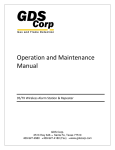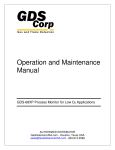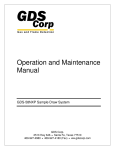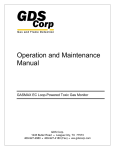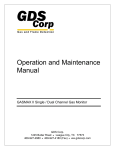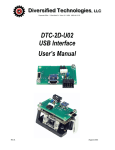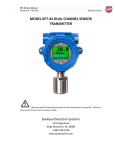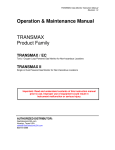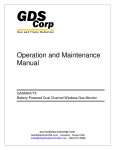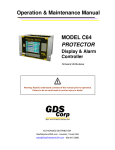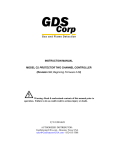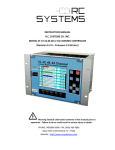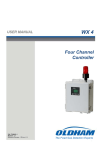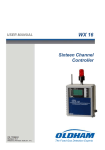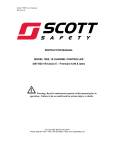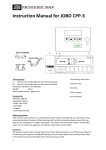Download GDS GDS-78XP User Manual
Transcript
Operation and Maintenance Manual GDS-78XP Process Monitor for Hazardous Area Applications AUTHORIZED DISTRIBUTOR GasDetectorsUSA.com - Houston, Texas USA [email protected] - 832-615-3588 GDS-78XP Operation & Maintenance Manual, Revision 2.0 CAUTION: FOR SAFETY REASONS THIS EQUIPMENT MUST BE OPERATED AND SERVICED BY QUALIFIED PERSONNEL ONLY. READ AND UNDERSTAND INSTRUCTION MANUAL COMPLETELY BEFORE OPERATING OR SERVICING. ATTENTION: POUR DES RAISONS DE SÉCURITÉ, CET ÉQUIPEMENT DOIT ÊTRE UTILISÉ, ENTRETENU ET RÉPARÉ UNIQUEMENT PAR UN PERSONNEL QUALIFIÉ. ÉTUDIER LE MANUE D’INSTRUCTIONS EN ENTIER D’UTILISER, D’ENTRETENIR OU DE RÉPARER L’ÉQUIPEMENT. REVISION HISTORY Revision 2.0 5/20/14 Revised and Updated for GASMAX CX Copyright © 2014 GDS Corp. All Rights Reserved P/N 1200-0712-02 Page 2 AVANT GDS-78XP Operation & Maintenance Manual, Revision 2.0 CONTENTS 1 SAFETY INFORMATION _______________________________________________ 6 2 OVERVIEW _________________________________________________________ 7 Introduction ________________________________________________________________ 7 Explosion Proof Installation ____________________________________________________ 7 Intrinsically Safe Installation ___________________________________________________ 7 3 HARDWARE ________________________________________________________ 8 Overview __________________________________________________________________ 8 Sensor Considerations ________________________________________________________ 8 4 INSTALLATION _____________________________________________________ 10 Selecting a Location _________________________________________________________ 10 Ethernet Connection ________________________________________________________ 10 USER Power & Signal Connections _____________________________________________ 11 Relay Connections (Optional) _________________________________________________ 11 MODBUS Connections (Optional) ______________________________________________ 12 AC Heater (Optional) ________________________________________________________ 13 Sample Inlet _______________________________________________________________ 13 Filter Drain & Filter Bypass ___________________________________________________ 14 Sample Exhaust ____________________________________________________________ 15 Installation Summary: Do’s and Don’ts __________________________________________ 15 5 SETUP & OPERATION ________________________________________________ 16 Flow Setup ________________________________________________________________ 16 GASMAX CX DIsplay _________________________________________________________ 16 Alarm Setup _______________________________________________________________ 17 Page 3 GDS-78XP Operation & Maintenance Manual, Revision 2.0 6 CALIBRATION ______________________________________________________ 18 7 MAINTENANCE_____________________________________________________ 20 Normal Maintenance ________________________________________________________ 20 Fault and Overrange Conditions _______________________________________________ 20 Sensor Replacement ________________________________________________________ 21 8 TROUBLESHOOTING GUIDELINES ______________________________________ 22 9 SPECIFICATIONS ____________________________________________________ 24 10 USER MENUS ____________________________________________________ 25 11 MODBUS REGISTERS ______________________________________________ 32 12 SPARE PARTS ____________________________________________________ 40 13 DRAWINGS AND DIMENSIONS ______________________________________ 47 Page 4 GDS-78XP Operation & Maintenance Manual, Revision 2.0 TABLE OF FIGURES FIGURE 3-1: GDS-78XP PROCESS MONITOR WITH XP FLOW SWITCH ............................................................ 8 FIGURE 4-1: GDS-78XP PROCESS MONITOR WITH XP FLOW SWITCH AND GDS-IR SENSOR ........................ 10 FIGURE 4-2: GDS-78XP POWER, SIGNAL & ETHERNET WIRING .................................................................... 11 FIGURE 4-3: RELAY / MODBUS CONNECTIONS ............................................................................................. 11 FIGURE 4-4: MODBUS WIRING JUNCTION BOX ............................................................................................ 12 FIGURE 4-5: 200W AC HEATER WIRING........................................................................................................ 13 FIGURE 4-6: FILTER DRAIN & EXHAUST TUBING RECOMMENDATIONS ....................................................... 14 FIGURE 5-1: GDS-78XP GASMAX DISPLAY SEQUENCE: DISPLAY SCREEN & TREND SCREEN ........................ 17 FIGURE 6-1: GDS-78XP CALIBRATION SETUP ................................................................................................ 19 FIGURE 10-1: MAIN MENU TREE .................................................................................................................. 25 FIGURE 10-2: ALARM OUTPUTS MENU TREE ............................................................................................... 26 FIGURE 10-3: CHANNEL SETTINGS MENU TREE (1) ...................................................................................... 27 FIGURE 10-4: CHANNEL SETTINGS MENU TREE (2) ...................................................................................... 28 FIGURE 10-5: COMM SETTINGS MENU ........................................................................................................ 29 FIGURE 10-6: SYSTEM SETTINGS MENU TREE .............................................................................................. 30 FIGURE 10-7: DIAGNOSTICS MENU TREE ..................................................................................................... 31 FIGURE 12-1: SAMPLE CONDITIONING OPTION 1 WITH FLOW SWITCH (SPARE PARTS) ............................. 40 FIGURE 12-2: SAMPLE CONDITIONING OPTION 1 WITH FLOW SWITCH & GDS-IR (SPARE PARTS).............. 41 FIGURE 12-3: SAMPLE CONDITIONING OPTION 2 WITH FLOW SWITCH (SPARE PARTS) ............................. 42 FIGURE 12-4: SAMPLE CONDITIONING OPTION 2 WITH FLOW SWITCH & GDS-IR (SPARE PARTS).............. 43 FIGURE 12-5: SAMPLE CONDITIONING OPTION 3 WITH FLOW SWITCH (SPARE PARTS) ............................. 44 FIGURE 12-6: SAMPLE CONDITIONING OPTION 3 WITH FLOW SWITCH & GDS-IR (SPARE PARTS).............. 45 FIGURE 12-7: GDS-78XP SENSOR HEAD EXPLODED VIEW ............................................................................ 46 FIGURE 13-1: GDS-78XP DIMENSIONS (PLATE) ............................................................................................ 47 FIGURE 13-2: GDS-78XP DIMENSIONS (NEMA 4X STAINLESS ENCLOSURE) ................................................. 48 Page 5 GDS-78XP Operation & Maintenance Manual, Revision 2.0 1 SAFETY INFORMATION Important – Read Before Installation Users should have a detailed understanding of GDS-78XP operating and maintenance instructions. Use the GDS-78XP only as specified in this manual or detection of gases and the resulting protection provided may be impaired. Read the following WARNINGS prior to use. WARNINGS • • • • • • • • The GDS-78XP process monitor described in this manual must be installed, operated and maintained in accordance with information contained herein. Installation in any hazardous area must comply with all applicable restrictions, requirements and guidelines for said hazardous areas. It is the end user customer’s final decision to ensure that the GDS-78XP is suitable for the intended use. The GDS-78XP is designed and constructed to measure the level of certain gases in backgrounds that contain free oxygen. Accuracy in atmospheres containing steam or inert gases cannot be guaranteed. Do not paint enclosure, transmitter or sensor assembly. Do not operate the GDS-78XP if its enclosure is damaged or cracked or has missing components. Make sure the cover, internal PCB’s and field wiring are securely in place before applying power. Do not expose the GDS-78XP to electrical shock or continuous severe mechanical shock. Protect the GDS-78XP from dripping liquids and high power sprays. Calibrate with known target gas at start-up and check on a regular schedule, at least every 90 days. More frequent inspections are encouraged to spot problems such as dirt, oil, paint, grease or other foreign materials in the sample tubing or in the sensor head. Periodically test for correct operation of the system’s alarm events by exposing the sample extraction point to a calibration gas concentration above the High Alarm set point. Use only for applications described within this manual. WARRANTY GDS Corp. UPS products carry a 2-year limited repair or replacement warranty on electronics and workmanship and one year warranty on sensors. GDS Corp. reserves the right to void warranty claims based on evidence of misuse, abuse, or misapplication. Warranty period starts on date of shipment. IF YOU HAVE QUESTIONS GDS Corp 2513 FM 646 Road North, Santa Fe, Texas, 77510 409-927-2980 (Office), 409-927-4180 (Fax) [email protected] www.gdscorp.com Page 6 GDS-78XP Operation & Maintenance Manual, Revision 2.0 2 OVERVIEW INTRODUCTION Thank you for choosing the GDS Corp GDS-78XP Process Gas Monitor for Hazardous Area Applications. The GDS-78XP Process Gas Monitor is designed to provide continuous monitoring for gas Sample Flow Meter sample streams that are compatible with standard Flex electrochemical, infrared and photoionization sensors. The GDS-78XP combines the industrySample Outlet proven reliability and performance of GDS Corp GASMAX gas monitors with high quality sample Run / Cal Valve Sample Inlet Cal Gas Inlet conditioning and flow measurement components Filter Drain to deliver cost-effective solutions for process GDS Corp monitoring applications. The GDS-78XP is designed to operate with samples from pressurized sources between +1 psig and +3000 psig depending on sample conditioning hardware. EXPLOSION PROOF INSTALLATION The GDS-78XP is designed for use in Class 1 Division 1 hazardous areas. Installation in these areas should follow best industry standard practices and all appropriate electrical codes. Generally, these codes require rigid metal conduit, poured seals and other installation elements necessary to ensure safety. For maximum protection against RF interference or electrical surge, the GDS-78XP enclosure and interconnecting conduit must be properly grounded. INTRINSICALLY SAFE INSTALLATION The GDS-78XP is not designed or certified for use as an Intrinsically Safe device. Page 7 GDS-78XP Operation & Maintenance Manual, Revision 2.0 3 HARDWARE OVERVIEW The GDS-78XP uses low cost, reliable electrochemical sensors to detect hydrogen sulfide, mercaptan, THT and other trace gases in process streams that contain little or no oxygen. As electrochemical sensors require oxygen to operate, the GDS-78XP alternatively exposes the sensor to the process flow and then purges the sensor with ambient air to maintain the sensor in a sensitive, oxygenated state. Power Input Signal Output Flow Switch GASMAX CX Gas Monitor Flow Meter Sensor & Flow Cell Sample Outlet Sample Inlet Run / Cal Valve GDS Corp Figure 3-1: GDS-78XP Process Monitor with XP Flow Switch At the beginning of each sequence, the GDS-78XP performs Conditions the Sensor by allowing a small sample of gas to enter the SENSOR CONSIDERATIONS For toxic gases the GDS-78XP supports a wide range of electrochemical (“echem”) sensors. These sensors use chemical reactions to sense the presence of gases such as hydrogen sulfide, sulfur dioxide and many others. Each sensor contains an amount of chemical electrolyte that reacts with the target gas to create free electrons that are amplified and measured. Once the electrolyte is depleted, sensor output will diminish and the sensor must be replaced. Page 8 GDS-78XP Operation & Maintenance Manual, Revision 2.0 IMPORTANT: TOXIC SENSORS ARE SUBJECT TO ACCELERATED DETERIORATION IF POWER IS NOT APPLIED WITHIN 3 MONTHS OF SHIPMENT FROM GDS CORP. For combustible gases the GDS-78XP supports both a traditional catalytic bead (“cat bead”) sensor and the GDS-IR infrared sensor. Catalytic bead sensors ‘burn’ combustible gas using a catalyst that operates at high temperature. An increase in temperature indicates the presence of gas. Catalytic bead sensors can detect any combustible gas, but the fact that the active bead is in direct contact with the gas can result in damage or reduced sensitivity if the gas contains chemicals that deactivate or temporarily inhibit the operation of the catalyst. Catalytic material is used each time the sensor is exposed to combustible gas and as a result the sensor will lose sensitivity over time. Infrared sensors use the fact that hydrogen-carbon bonds found in all hydrocarbon gases absorb infrared light at certain frequencies. The sensor is designed such that the target passes between the source and detector, and a reduction in detector output indicates the presence of gas. Infrared sensors cannot be poisoned or damaged by chemicals in the target gas and typically have a long life. GDS-IR sensors carry a 5 year warranty on the electronics and a 12 year warranty on the IR source. IMPORTANT: INFRARED SENSORS CANNOT DETECT COMBUSTIBLE LEVELS OF HYDROGEN GAS Photoionization detectors (PID sensors) are used to detect volatile organic compounds such as benzene or toluene. PID sensors use high energy ultraviolet light to partially ionize complex molecules and measure the resulting free electrons. Each VOC has a different ‘ionization potential (IP)’ energy level that is measured in ‘electron-volts’, or eV, and a given PID sensor will detect all compounds present with IP values that are equal to or lower than the rated eV of the PID sensor lamp. PID sensor lamps eventually wear out and can be factory refurbished. Page 9 GDS-78XP Operation & Maintenance Manual, Revision 2.0 4 INSTALLATION SELECTING A LOCATION Install the GDS-78XP in a suitable location, as close as possible to the point of intended sample extraction. The GDS-78XP back plate is an industry standard size and features mounting holes that can be used to securely attach the monitor to a bulkhead or wall. Make sure there is sufficient clearance to install the sample inlet tubing and sample outlet tubing. Also make sure that the Run / Cal valve can operate freely and that access to the Cal Port is not blocked for any reason. Power Input Signal Output Sample Flow Meter Flex Tubing Run / Cal Valve Sample Inlet Sample Outlet Cal Gas Inlet Sample Inlet Sample Outlet Filter Drain GDS Corp Filter Drain Figure 4-1: GDS-78XP Process Monitor with XP Flow Switch and GDS-IR Sensor ETHERNET CONNECTION The GASMAX CX gas monitor includes a standard RJ-45 Ethernet connection on the main I/O board. Both fixed IP and DHCP-based dynamic IP addressing is supported. The GASMAX CX supports a full range of MODBUS / TCP accessible register (see Chapter 10) as well as a built-in web server with data display and gas detector configuration page. See Figure 5-2. Page 10 GDS-78XP Operation & Maintenance Manual, Revision 2.0 USER POWER & SIGNAL CONNECTIONS To access the power and signal wiring, remove the cover from the explosion proof enclosure. Connect a source of +24VDC to TB1 pins 1 (+) and 4 (-) as shown below. Analog 4-20mA signal output is connected to TB1 pin 2. Channel 2 output on pin 3 is not used in this application. Terminal Block TB1 1 Power Input (+18-30V) 2 Channel 1 Output 3 Channel 2 Output (Not used*) 4 Power Ground Ethernet Connection Figure 4-2: GDS-78XP Power, Signal & Ethernet Wiring RELAY CONNECTIONS (OPTIONAL) The optional GASMAX CX Relay / dual MODBUS RTU slave interface is connected “piggyback” to the back of the GASMAX CX Display Assembly and supplies three level alarm relays, a FAULT relay and dual RS-485 Modbus RTU serial ports. Remote Alarm Acknowledge Modbus Wiring: 1 Modbus A 2 Modbus B 3 Shield Tie Point 4 Modbus A 5 Modbus B TB2 1 2 3 4 5 A B S A B TB1 MODBUS interface Relay Wiring: 1 Fault 1 NC 2 Fault 1 Common 3 Fault 1 NO 4 Relay 3 NC 5 Relay 3 Common 6 Relay 3 NO 7 Relay 2 NC 8 Relay 2 Common 9 Relay 2 NO 10 Relay 1 NC 11 Relay 1 Common 12 Relay 1 NO Figure 4-3: RELAY / MODBUS Connections Relays K1, K2 and K3 provide a contact closure if the Alarm 1 (“K1”) or Alarm 2 (“K2”) or Alarm 3 (“K3”) limits are exceeded. Alarms can be programmed to trigger above or below a certain value, work as normal or ‘failsafe’ and can be made to latch if desired. Relay K3 indicates a FAULT condition in the sensor, microprocessor or flow system. Page 11 GDS-78XP Operation & Maintenance Manual, Revision 2.0 Remote Alarm Reset can be used to acknowledge an Alarm 2 relay contact closure. Wiring from any remote pushbutton to TB3 should be shielded and protected from noise spikes to prevent false Alarm Reset commands. WARNING: RELAY CONTACTS ARE RATED FOR RESISTIVE LOADS ONLY! INDUCTIVE LOADS MAY CAUSE ARCING WHICH SHORTENS LIFE AND MAY INTERFERE WITH SENSOR DATA. MODBUS CONNECTIONS (OPTIONAL) The dual optional GDS-78XP MODBUS RTU interface allows remote controllers or PLCs to monitor most aspects of operation, including real-time data, range and alarm setpoints and alarm and fault status bits. The GDS-78XP interface supports 9600 Baud RS-485 differential signaling only. Access to each MODBUS RS-485 interface is via TB2 on the optional Relay / MODBUS board mounted on the back of the GASMAX CX display module MODBUS system architecture requires that the devices in any MODBUS loop be connected in a daisy-chain layout. This minimizes signal reflections and improves signal noise margin. A +24 GND “A” “B” MODBUS Termination Jumper installs a load resistor across the MODBUS signal lines and should only be set to “A” (ON) at the last device in the string. +24 GND A PWR to integrity and power distribution. For MODBUS data signals, GDS MODBUS to Cable selection for MODBUS systems is important for both signal Corp recommends 20GA to 24GA twisted shielded cable. Daisychain power distribution may require larger gauge wire since it is +24 GND A critical that the supply voltage for the GDS-78XP at the far end of the string not fall below 20VDC during power-up. +24 GND “A” “B” Note that while the GDS-78XP has two sets of wiring terminals for MODBUS “A” and “B” signals, daisy-chain power wiring requires that two wires be installed in the “+24” and “GND” terminals on the GDS-78XP I/O Power Supply board. This can be difficult if wire sizes are larger than #18GA. For these reasons, if MODBUS is Figure 4-4: MODBUS Wiring Junction Box required GDS Corp recommends the addition of the MODBUS Wiring Junction Box (see Fig. 5-7). This option minimizes the need to access wiring inside the GDS-78XP, provides individual wire landing points for incoming and outgoing MODBUS and power wiring and shields, and makes it easy to temporarily disconnect the GDS-78XP power or MODBUS connections without affecting any other MODBUS device. Page 12 GDS-78XP Operation & Maintenance Manual, Revision 2.0 AC HEATER (OPTIONAL) The 200 watt AC-powered heater is recommended for outdoor applications where ambient temperatures may fall below freezing for extended periods of time. The heater is available in either 110VAC or 230VAC models. Access to the heater wiring is via a separate ¾” NPT fitting on the bottom of the heater junction box. Note that all high voltage AC wiring must be kept separate from lower voltage DC and signal lines. Fixed Thermostat (ON below 50°F / 10°C) Heater Element Access to heater wiring via ¾” NPT fitting on bottom of junction box (enclosure cutout not provided) Thermostat AC HOT AC NEUTRAL AC GND Black Red/White Green Heater Element Figure 4-5: 200W AC Heater Wiring Local codes and good wiring practice require an AC shutoff switch within sight of the heater assembly for maintenance and testing. IMPORTANT: Keep all electrical fittings tight while circuits are alive. SAMPLE INLET Attach a length of tubing to the Sample Inlet using the supplied ¼” compression fitting. The GDS78XP uses a variable area flow meter or high pressure regulator to monitor and control sample flow. For option #1, inlet pressure must be maintained between 1.0 psig and 50 psig, and must remain within ±10% of the nominal value. Excessive changes in sample inlet pressure will proportionally change the sample flow rate; rates below or above the desired 0.5 liter per minute rate may cause incorrect readings. If the optional low-flow switch is included, flow rates Page 13 GDS-78XP Operation & Maintenance Manual, Revision 2.0 below the desired value will cause the FAULT relay to activate (if installed). Options #2 and #3 employ a high pressure regulator and maintain a fixed flow rate over a wide range of inlet pressures. FILTER DRAIN & FILTER BYPASS All GDS-78XP configurations include a coalescing filter with stainless steel drain valve. The drain valve should be opened periodically to release any built-up liquid that may have been trapped inside the filter. Conversely, the filter drain valve may be left ‘cracked open’ to allow moisture (and sample gas) to escape on a continuous basis. Models with the combination coalescing and membrane filter include a bypass valve that should be opened slightly to maintain a constant flow of sample across the membrane element to carry away moisture and particulates captured by the filter. Filter Drain Recommendations 1) Including a length of clear tubing in the filter drain line makes it easy to monitor the drain for the presence of moisture 2) Filter drain and filter bypass drain can be combined in the same manifold 3) Filters in sample draw units should only be drained during sample purge or purge / hold times to keep ambient air from being drawn into the GDS-78XP by the sample pump IMPORTANT: DO NOT TIE SAMPLE EXHAUST TO A COMMON EXHAUST MANIFOLD. MAINTAIN A SEPARATE SAMPLE EXHAUST LINE TO AMBIENT AIR. Figure 4-6: Filter Drain & Exhaust Tubing Recommendations NOTE: IF SUFFICIENT PRESSURE EXISTS IN THE INPUT LINE, LEAVING THE FILTER DRAIN VALVE ‘CRACKED’ OPEN WILL ALLOW SAMPLE GAS TO FLOW FROM THE PICKUP POINT TO THE GDS-78XP ON A CONTINUOUS BASIS, ENSURING THAT FRESH SAMPLE IS ALWAYS AVAILABLE AT THE SENSOR. Page 14 GDS-78XP Operation & Maintenance Manual, Revision 2.0 SAMPLE EXHAUST Changes in ambient pressure will affect the output from all electrochemical sensors, and allowing the sample to exhaust directly to atmosphere will minimize these affects. Long runs of tubing connected to the sample outlet may increase the backpressure inside the sensor flow cell and cause higher than normal readings. Hydrogen sulfide, for example, is a heavy gas and will tend to ‘back up’ inside sample exhaust lines that extend vertically for too great a distance. IMPORTANT: DO NOT RESTRICT SAMPLE EXHAUST OUTLET. PRESSURE IN THE SAMPLE FLOW CELL MAY DAMAGE THE SENSOR AND WILL RESULT IN INCORRECT READINGS. IMPORTANT: WHEN INSTALLING THE GDS-78XP OUTDOORS, MAKE SURE SAMPLE EXHAUST IS PROTECTED BY A SCREEN OR FILTER TO KEEP INSECTS FROM ENTERING THE EXHAUST PORT AND NESTING IN THE SENSOR FLOW CELL. DANGER: MAKE SURE EXHAUST GAS IS DIRECTED AWAY FROM PERSONNEL AND EQUIPMENT, ESPECIALLY SUMPS OR LOW-LYING AREAS WHERE HEAVY GASES, SUCH AS HYDROGEN SULFIDE, CAN BUILD UP OVER TIME. HYDROGEN SULFIDE OR OTHER TOXIC GASES ARE DEADLY AND EXPOSURE CAN RESULT IN INJURY OR DEATH. INSTALLATION SUMMARY: DO’S AND DON’TS • Select an installation location that protects the unit from shock, vibration and damage • Always mount the GDS-78XP vertically to ensure proper operation of the low flow switch • Make sure the power wiring is appropriate for the DC load and distance • Keep DC signal wiring and AC heater wiring separate • Make sure sample conditioning is appropriate to the quality of the sample • Observe maximum inlet length recommendations • Always provide an independent sample exhaust line • Make sure that exhaust gas is directed away from personnel and vented to a safe area where exhaust gas can dissipate • If mounting the unit outdoors, protect all exposed vents or intakes with screens or filters to keep insects, moisture or dirt from entering the device. Page 15 GDS-78XP Operation & Maintenance Manual, Revision 2.0 5 SETUP & OPERATION FLOW SETUP Once hardware installation is completed, apply power to the GDS-78XP and verify that the GASMAX display is operational. Open the inlet valve and adjust the flow meter for approximately ½ scale, or about 0.5 liters per minute. If the flow meter does not indicate proper flow, check the inlet tubing for restrictions or blockage. If full scale flow cannot be obtained, check the sample outlet tubing for blockage. See Table 1 for recommended flow meter settings for gases of different density. To check the Low Flow switch (if installed), set the Run / Cal valve to the CAL position. After ten seconds the display should flash RED and the message “FAULT” should appear. GASMAX CX DISPLAY There are four magnetic switches on the face of the GASMAX CX, “UP/RST” “NEXT” arranged in a quadrant around the LCD display. Starting in the upper left and proceeding clockwise these are labeled UP, NEXT, EDIT and DN/CAL. To activate, or “press” a magnetic switch, swipe the magnet near the switch. For the balance of this manual, the term “press” will be used to describe activation of any key via the magnetic wand. Below the LCD display, two LEDs monitor the MODBUS RS-485 or Ethernet network interface. Flashing indicates sent or received “DN/CAL” “EDIT” data. Pressing the NEXT key momentarily causes the GDS-78XP display to sequence display and trend screens. The Display Screen (shown) shows the calibrated engineering units, analog bar graph, tag (measurement) name and engineering units (“ppm”). The Trend Screen displays a graph that shows the most recent 30 minutes of data as well as alarm levels. Pressing the DOWN/CAL key, followed by the EDIT key, initiates Calibration Mode. For a detailed description of calibration, see Chapter 6. Pressing the EDIT key activates the USER MENU mode (See Chapter 9). During USER MENU mode, the UP, DN and NEXT keys are used to select and confirm menu entries. The USER MENU allows the operator to view the Event Log and channel parameters and change system settings such as alarm levels and real time clock day and date. Page 16 GDS-78XP Operation & Maintenance Manual, Revision 2.0 Figure 5-1: GDS-78XP GASMAX Display Sequence: Display Screen & Trend Screen ALARM SETUP Using a magnetic wand, select the GASMAX Main Menu by placing the magnet next to the EDIT switch located on the lower right side of the GASMAX II display. Select Channel 1 and then ALARMs to adjust the desired level, polarity, on/off delays and other alarm-related settings. NOTE: ALARM SETTINGS ONLY AFFECT THE GASMAX LCD DISPLAY COLOR IF LOCAL RELAYS ARE NOT INSTALLED. LOCAL ALARM SETTINGS WILL HAVE NO EFFECT ON ALARM SETTINGS AT ANY REMOTE DEVICE THAT MONITORS THE GDS-78XP 4-20MA OUTPUT. Page 17 GDS-78XP Operation & Maintenance Manual, Revision 2.0 6 CALIBRATION Calibration is critically important to ensure correct operation of the GDS-78XP. The built-in CAL MODE function is designed to make calibration quick, easy and error free; a successful ZERO and SPAN calibration requires only four keystrokes. During CAL MODE zero and span, the sensor output is disconnected and the GDS-78XP transmits a fixed mA value, called the CAL MARKER, to notify the receiving device that a calibration is in progress. During the following CAL PURGE DELAY time, the GDS78XP transmits a fixed 4.0 mA signal to prevent external alarms during calibration. In the case of Oxygen sensors, during CAL PURGE DELAY the output simulates a typical atmospheric reading of 20.8%. CAL MODE automatically exits if no keystrokes are detected after 5 minutes. Follow these GDS-78XP calibration guidelines: • Calibration accuracy is only as good as the calibration gas accuracy. GDS Corp calibration gases are traceable to NIST (National Institute of Standards and Technology). • Never use calibration gas that has passed its expiration date. • Check the SPAN GAS VALUE setting and make sure it matches the calibration gas. (See Fig. 6-2) • Always use a GDS Corp calibration cup that completely surrounds the sensor head. • Be sure to use ZERO AIR, a mixture of 21% oxygen and 79% nitrogen, as a zero reference unless you are certain that no target gas exists in the area. Ambient gas may result in an ‘elevated zero’ condition that will cause a FAULT to occur once the ambient gas is no longer present. • Always calibrate a new sensor before depending on the device for personnel or equipment safety • Calibrate on a regular schedule. GDS Corp recommends a full calibration every 3 months, with periodic ‘bump tests’ on a more frequent basis to ensure that the sensor has not been affected by temperature extremes or the presence of incompatible gases. CALIBRATION PROCEDURE Before beginning calibration, make sure you have the following items: A cylinder of calibration gas, fixed flow regulator and a length of flexible tubing. A cylinder of ‘zero air’ may be necessary if the absence of target gas cannot be confirmed in the sample area. To calibrate a GDS-78XP sample draw: 1. If using Zero Air, set the Run/Cal valve to the CAL position (pointing to the right) and connect the cylinder of zero air to the GDS-78XP calibration port. Turn on the regulator and verify flow on the flow meter. Otherwise, allow the current sample to continue to flow into the GDS-78XP. 2. Press the DOWN / CAL key and within 5 seconds press the EDIT key to enter CAL MODE. Page 18 GDS-78XP Operation & Maintenance Manual, Revision 2.0 3. The screen will display “APPLY ZERO”. Allow a few seconds for the reading to stabilize and press the EDIT key to complete the ZERO calibration. A “ZERO CAL SUCCESSFUL” message should appear. 4. If not already done, set the Run/Cal value to the CAL position and connect the cylinder of span gas. 5. When the “APPLY SPAN” message appears, turn on the regulator and verify flow on the flow meter. After the reading is stable, (approximately 1-2 minutes) press the EDIT key to complete the SPAN GAS calibration. If the SPAN calibration is successful, the display flashes REMOVE CAL GAS and starts the CAL PURGE delay. 6. Immediately shut off the regulator and set the Run/Cal valve to RUN. At the end of the CAL PURGE delay, the GDS-78XP output is re-enabled and the unit is fully operational. Fixed Flow Regulator Cylinder of Span Gas or Zero Air Figure 6-1: GDS-78XP Calibration Setup Page 19 GDS-78XP Operation & Maintenance Manual, Revision 2.0 7 MAINTENANCE Once setup is complete, user intervention is not required and the GDS-78XP automatically measures and outputs the gas concentration on a continuous basis. NORMAL MAINTENANCE Standard maintenance for the GDS-78XP consists of periodic checks on flow settings and sensor calibration. Each time a toxic sensor is calibrated, a Sensor Life reading will appear that gives an approximate indication of the remaining sensitivity. Sensor Life is not necessarily linear and a rapid reduction in the senor life reading can be due to temperature extremes, high levels of target gas, the presence of certain gases that ‘poison’ toxic sensors and other environmental factors. Always check the flow meter for the presence of moisture. In the event that moisture or liquid is drawn in the GDS-78XP, the entire unit should be disassembled and cleaned. In some cases the flow meter or flow switch may need to be replaced. If liquid is drawn into the GDS-78XP, always inspect the sensor for signs of damage. FAULT AND OVERRANGE CONDITIONS The GASMAX CX gas detector continuously monitors the sensor for fault or overrange conditions. The fault setting is user adjustable and is typically set for -5% to -10% of scale (default). Electrochemical sensors that show fault are defective and should be replaced. Bridge-type sensors, such as catalytic bead or PID sensors allow the zero value to be adjusted and can often be rebalanced to normal operation. However, if this happens regularly then the sensor may be defective or the gas stream may contain one or more compounds that affect the sensor. In the event of an overrange condition, the 4-20mA output will exceed 20mA and the display will indicate OVERRANGE or FAULT. Page 20 GDS-78XP Operation & Maintenance Manual, Revision 2.0 SENSOR REPLACEMENT If a sensor shows FAULT, does not respond to gas or can no longer be calibrated, it should be replaced. Use type 10-98XX-Ryyyy sensors, where the XX is gas type (Fig. 3-1) and yyyy is range (25 = “0025”). 1 Step 1: Turn off DC power. Step 2: Disconnect the sample inlet tube at 2 the sensor flow cell Step 3: Disconnect the sample exhaust tube at the flow cell. 3 Step 4: Unscrew the sensor flow cell and sensor head cover Step 5: Pull straight down to remove the existing sensor. 5 6 Step 6: Compare the new sensor with the old sensor and verify identical part numbers 4 Step 7: Install the new sensor by aligning the arrow on the sensor with the arrow on the sensor head and pushing straight up. Step 8: Reassemble the sensor head cover and flow cell and reattach the sample inlet and 7 outlet tubing. Step 9: Apply power, allow the sensor to 8 warm up for several hours. Step 10: Perform a complete calibration. Page 21 GDS-78XP Operation & Maintenance Manual, Revision 2.0 8 TROUBLESHOOTING GUIDELINES Fault Indication on Output Channel • Fault or Overrange on power-up. Certain toxic sensors indicate off-scale low or high at power up and quickly drift towards zero. This is normal behavior. • Continuous Fault indication. Remove sensor and examine for moisture or discoloration. Replace sensor if wet or discolored. Fault indication generally indicates sensor useful life is exhausted. • Sensors left unpowered for more than 3 months are subject to accelerated degradation and may demonstrate a permanent loss of sensitivity. • Value shows -25% of scale – indicates SENSOR FAULT from GASMAX monitor. • Value shows +105% of scale – indicates an OVERRANGE condition, where the sample gas caused the sensor to read more than 100% of scale. Sensor Fails Calibration • Sensor reading during zero calibration exceeds upper limit of zero – sensor is defective and should be replaced. • Sensor reading during span calibration too low – sensor may be defective. However, it may be possible to temporarily continue operation by increasing PREAMP GAIN. GDS-78XP and Receiving Device Displayed Values Don’t Match • Check that zero and full scale range values match between GDS-78XP and receiving device (controller). Use DIAGNOSTICS menu to force the OUTPUT channel (Ch2) to 12mA and verify half-scale reading on remote controller. • Check for high impedance shorts to ground on 4-20mA wiring. • If 4-20mA output is off-scale low or high and cannot be adjusted using DIAGNOSTICS mode, IO/Power Supply board may be defective and should be replaced. Controller MODBUS Data Incorrect • Verify that MODBUS master is requesting data from correct data register (31002). • Verify that controller MIN and MAX count settings are correct. MIN counts should be “800” which corresponds to 4mA and MAX counts should be “4000” which corresponds to 20 mA. • Verify that the GDS-78XP MODBUS address matches the address programmed into the controller’s channel configuration. Controller Showing MODBUS COMM ERROR • Check for incorrect MODBUS polarity (swap “A” and “B” if unsure; no damage will occur). Page 22 GDS-78XP Operation & Maintenance Manual, Revision 2.0 • Verify that MODBUS master is requesting data from correct MODBUS address. • Verify that MODBUS master is requesting data from register 31002. • Verify that there are no other MODBUS slave devices with identical MODBUS address. GDS-78XP Display Blank • Verify DC power at IO/Power Supply board, TB2, terminals 1 (+24) and 4 (Gnd). • Verify ribbon cable connected between IO/Power Supply board and Display Assembly. Page 23 GDS-78XP Operation & Maintenance Manual, Revision 2.0 9 SPECIFICATIONS Model Power Input Display GDS-78XP Process Monitor for Low Oxygen Applications 24VDC ± 5% at < 10 watts High resolution color LCD with engineering units, bargraph and 30-minute trend Sensor Types Electrochemical sensors for toxic gases, infrared sensors for combustibles or CO2 Sample Conditioning Sample conditioning option #1: 1.0 psig to 50 psig; inlet pressure must remain constant with ±10% of nominal value; 0.1 micron coalescing filter with high quality glass flow meter Sample conditioning option #2: 10 psig to 3000 psig; stainless steel filter with 0.1 micron coalescing element and high pressure regulator. Sample conditioning option #3: 10 to 1500 psig; stainless steel combination coalescing and membrane filter with 0.1 micron coalescing element and high pressure regulator. Accuracy +/- 5% of full scale (typical) Standard Output Three-wire 4-20mA current source outputs with fault and overrange indication. Maximum loop resistance is 750 ohms with standard 24VDC supply. Ethernet RJ-45 with built-in MODBUS/TCP interface and web server Optional Relay / MODBUS interface with 3x 5A SPDT programmable alarm relays. Temperature (operating) 0°C to +50°C standard (no enclosure) -20°C to +50°C with NEMA 4X enclosure and optional 200W AC heater. Heater thermostat is set to 50°F and is not user-adjustable. Temperature (inert) -20°C to +55°C In cold weather, GDS Corp recommends turning on the AC heater (if installed) for several hours before applying DC power Memory Materials On-board non-volatile memory retains all user settings Instrument housings: Aluminum Tubing & fittings 316 stainless steel Dimensions Painted steel plate: 12.8” x 14.8” x 8”, NEMA 4x non-metallic enclosure, 24” x 24” x 8” Approvals GASMAX CX Gas Monitor CSA Certified Class I, Div 1 & 2 Groups B, C, D. Sequencer enclosure CSA certified for use in Class I Div 1 areas. Flame arrestors UL certified for use in Class 1 Div 1 areas. Warranty Two years on electronics Page 24 GDS-78XP Operation & Maintenance Manual, Revision 2.0 10 USER MENUS The GASMAX CX gas monitor used in the GDS-78XP has a menu-driven user interface that allows the operator to review and adjust a wide range of settings. In the GDS-78XP, channel 1 of the GASMAX CX measures the “raw sensor” gas level and channel 2 provides continuous display, output and alarming on the stored value retained in the sequencer memory. To access the Main Menu, activate the EDIT key with a magnetic wand. Main Menu Alarm Outputs Channel Settings Comm Settings Security System Diagnostics → → → → → → Alarm Outputs Relay 1 → Relay 2 → Relay 3 → Alarm Output Menu – contains settings that control the four optional alarm relays (if installed). These setting include relay programming, on and off delay, failsafe mode and specific input override. Channel Settings Channel 1 → Channel 2 → Channel Settings Menu – contains settings specific to each channel. These include tag names, range, calibration settings and alarm levels. Comm Settings COMM 1 Settings COMM 2 Settings ModbusTCP Network Settings Troubleshooting → → → → → Comm Settings Menu – contains settings specific to the Ethernet network interface, MODBUS/TCP interface and optional RS-485 serial ports (if installed). Security Code to Lock **** Modbus/Web Code 1234 Contact Info System Version v1.00 Configure → Digital Input → View Event Log → Clear Event Log → View Sensor Life → Diagnostics Relays Analog Inputs Analog Outputs LED Test Serial Ports ADC Readings → → → → → → Security Settings Menu – allows the user to restrict operation for some or all of the features as well as provide a programmed contact name. System Settings Menu – contains settings that are unit specific. These include unit name. time and date, warm-up and calibration delay settings, and Event Log. Diagnostics Menu – comprehensive set of tools that can be used to activate relays, simulate output values and test serial ports. Figure 10-1: Main Menu Tree Page 25 GDS-78XP Operation & Maintenance Manual, Revision 2.0 Alarm OUTPUTS Menu The Alarm Outputs Menu controls the four optional alarm relays (if installed). These setting include relay programming, acknowledge, failsafe mode and specific input override options. NOTE: The Alarm / Modbus board containing the 3x alarm relays and 1x fault relay is optional on the GDS-78XP. Alarm Outputs Relay 1 Relay 2 Relay 3 → → → All three relay outputs are identical and can be set to respond to channel 1 or channel 2 events. The fault relay is always dedicated to Relay x Alarm 1 Alarm 2 Alarm 3 Fault Acknowledge Failsafe Override Off Off Off Off No No None Alarm 1, 2, 3 and Fault – Determines which channel or combination of channels can activate the relay. Options are “Off”, “Ch1”, “Ch2”, “Ch1 and Ch2”, and “Ch1 or “Ch2”. Acknowledge – Determines if the alarm can be reset by an Acknowledge command (YES) or not (NO). Failsafe – Determines if the relay is OFF when inactive (NO) or ON when inactive (YES). Failsafe connections thru the Normally Open connection will open automatically if the alarm activates or if power is lost. Override – Allows the relay to be dedicated to a specific channel alarm level or function such as calibration. Settings that involve calibration allow None Ch1 Alarm 1 Ch1 Alarm 2 Ch1 Alarm 3 Ch1 Fault Ch2 Alarm 1 Ch2 Alarm 2 Ch2 Alarm 3 Ch2 Fault Ch1/2 Cal Zero Ch1 Cal Span Ch2 Cal Span 1/2 Cal Zero/Span the relay to be connected to a cylinder of calibration gas via a solenoid valve to enable automatic application of calibration gas if the unit is placed in Cal Mode. Figure 10-2: Alarm Outputs Menu Tree Page 26 GDS-78XP Operation & Maintenance Manual, Revision 2.0 Channel Settings Menu The Channel Settings Menu allows the user to adjust individual channel or sensor-specific features. Data in the Channel Settings Menu is uploaded from Smart Sensors, and written back to any local Smart Sensor if changed in the menu. Channel Settings Channel 1 → Channel 2 → All three relay outputs are identical and can be set to respond to channel 1 or channel 2 events. The fault relay is always dedicated to fault events. Channel x Alarm 1 Alarm 2 Alarm 3 Fault Alarm Data From Temp. Comp. Configure Calibrate Both channel setup menus are identical so only one is shown. → → → → → → → → Alarm X menu (all three alarm setting menus are identical) Set Point is the engineering unit value where the alarm trips. It may be negative or positive. Latching YES causes the alarm to remain active even after the event clears. NO clears the alarm automatically. Alarm x Setpoint 20.00 Latching No High Trip On Fault Off On Delay(sec) 0 Off Delay(min) 0 Dead Band % 1 Trip On HIGH causes the alarm to activate if the value goes above the setpoint. Trip On LOW activates the alarm if the value goes below the setpoint. On / Off Delay adjusts the time delay between the time when the event occurs and when the alarm is activated. Deadband prevents alarm cycling when the value is close to the alarm level. Fault Alarm Setpoint -10.00 Data From EC Sensor Remote Sensor No Min Raw 800 Max Raw 4000 Filter Samples 20 Polarity POS PGA Gain → Heater Enabled No Heat(degC) 10.0 Fault Alarm setpoint is typically set at -10% of full scale. Data From Menu Data From determines the source of the data for this channel. Min Raw / Max Raw – Set the range of the input A/D converter. Normally set to 800 (min) and 4000 (max). Useful if a sensor’s output does not provide a full range signal. Filter Samples – Number of samples used by the smoothing filter. PGA Gain – sets the analog amplification level in the smart sensor interface circuit. WARNING: Changing PGA gain resets calibration data. Heater Enabled – Determines if the internal sensor heater is ON or OFF. Heat(degC) – Heater thermostat setting. Figure 10-3: Channel Settings Menu Tree (1) Page 27 GDS-78XP Operation & Maintenance Manual, Revision 2.0 Temperature Compensation compensates for changes in sensor output (gain) and zero value (offset) as sensor temperature changes. Individual values for gain and offset can be entered for eleven points ranging from Temp. Comp. Temp Gain Offset -40 1.00 +0.00 -30 1.00 +0.00 -20 1.00 +0.00 -10 1.00 +0.00 0 1.00 +0.00 +10 1.00 +0.00 +20 1.00 +0.00 +30 1.00 +0.00 +40 1.00 +0.00 +50 1.00 +0.00 minus 40C to +60C. Gain and offset values are linearly interpolated between points by the internal microprocessor. NOTE: These values are typically set by the sensor manufacturer and should not be changed. Configure Menu Measurement Name – User-programmable character string to describe the channel. Otherwise called “tag name”. E. Units – User-programmable character string that describes the Configure Hydrogen Sulfide E. Units ppmH2S Zero 0.00 Span 100.0 Decimal Points 0 Channel On? Yes Deadband (%) 0.00 Backup/Restore → engineering units value. Zero – Channel zero value, typically “0”. Span– Channel full scale value. Max value is “9999”. Decimal Points – Determines the number of displayed digits to the right of the decimal point. Channel On? – Channel ON or OFF setting. An “OFF” channel will have no effect on any alarm or output value. Deadband (%) – The value, around zero, for which the screen will show “0.0”. Eliminates display of small values around zero due to sensor drift. Calibrate Offset 1.73 Gain 1.00 Cal Zero 0.00 Cal Span 100.0 Set Unity Gain → Backup / Restore Calibrate Menu Offset – Shows the computed offset value based on the latest calibration. Gain – Shows the computed gain value based on the latest calibration. Cal Zero – The value for the zero point calibration Cal Span – The value for span calibration, typically 50% of full scale. Set Unity Gain – Clears gain and offset to “1.00” and “0.00” respectively. WARNING: Set Unity Gain resets calibration data. Figure 10-4: Channel Settings Menu Tree (2) Page 28 GDS-78XP Operation & Maintenance Manual, Revision 2.0 Comm Settings Menu The Comm Settings Menu allows the user to configure the Ethernet interface, MODBUS/TCP slave and two optional RS-485 serial interfaces. Comm Settings COMM 1 Settings COMM 2 Settings ModbusTCP Network Settings Troubleshooting Comm X Menu (both comm port setting menus are identical) → → → → Type (“Modbus Slave”) determines whether the MODBUS port is a master or slave. Baud Rate – Sets the baud rate for the serial port. Options are 9600, → 19200, 38400, 57600 and 115200 baud. Slave ID - Sets the MODBUS slave ID for the serial port. Byte Order – sets the byte order for words larger than 16 bits. COMMx Settings Modbus Slave BaudRate 9600 Parity None Slave ID 42 Byte Order BADC Enable LEDs Yes Enable LEDs – If YES, front panel LEDs indicate MODBUS transmission. MODBUS TCP Menu Slave Settings: Byte Order – sets the byte order for words larger than 16 bits. Master Settings: ModbusTCP Slave Byte Order BADC Master Timeout(ms) 500 Poll Dly(ms) 250 Enable LEDs Yes Timeout – Length of time (in mSec) that master will wait for a reply before indicating a comm timeout. Poll Delay – Length of time (in mSec) between sequential read requests. Enable LEDs – if YES, front panel LEDs indicate MODBUS / TCP transmission Network Settings Menu DHCP Enabled – If YES, uses a remote DHCP server to establish a network Network Settings DHCP Enabled Yes Hostname Unit-44-1000 Ip Address 169.254.100.10 Netmask 254.254.0.0 address. If NO, uses fixed address. Hostname – Character string that defines device network name IP Address – Network address. If DHCP enabled, will show address assigned by DHCP server. If DHCP disabled, is IP address programmed by user. Net mask – Network mask value. See above. Gateway – Network gateway value. See above. Troubleshooting View Error Count Clear Error Count Troubleshooting Menu View Error Count – View a menu that tracks the number of network errors Clear Error Count – Resets number of network errors to zero. Figure 10-5: Comm Settings Menu Page 29 GDS-78XP Operation & Maintenance Manual, Revision 2.0 System Settings Menu The Comm Settings Menu allows the user to configure the Ethernet interface, MODBUS/TCP slave and two optional RS-485 serial interfaces. System Version v1.00 Configure → Digital Input → View Event Log → Clear Event Log → View Sensor Life → Configure Menu Date & Time – Sets the system date and time. Used for display and event log entries. Warm Up Delay – Sets length of time (in minutes) from power on to output signals active. During Warmup Delay the 4-20mA outputs are set to 4mA. Cal Purge Delay - Sets length of time (in minutes) that outputs are disabled following a zero or span calibration Configure Unit-44-1000 Date 01/25/2013 Time 04:33:05 Warmup(m) 1 Cal Purge(m) 1 Block Neg No Send SensrLife No InCal mA 0.00 Alm Refresh(m) 0 Block Negative – If YES, blocks screen from showing negative values. Send Sensor Life – If YES, enables transmission of sensor life data across 420mA output (see GASMAX CX manual for more details). InCal mA – Sets the 4-20mA output value to be transmitted during a calibration sequencer. Enables remote devices to track “In Cal” status. Alarm Refresh – See GASMAX CX manual. Digital Input Menu Digital Input Mode Flt Override Normally Open Channel Ch. 1 & 2 Mode – Determines action if digital input (fault ack input) is activated. Normally – If Normally OPEN the action will occur if the contacts close; if normally CLOSED the event will occur if the contacts open. Channel – Determines which channel output is affected. Hh:mm Ch Event 01/25/2013 03:35 2 Fault Out 03:34 2 Fault In 03:33 2 Fault Out 03:32 2 Fault In Event Log Event Log Format – The event log includes the date, time and list of events that occur. Events include cold boot, system boot, alarm reset, remote alarm reset, log cleared, config edit, A1, A2 and A3 in and out, fault in and out, calibration in and out, calibration fail, communications error, config error and marker event. Ch.1 Sensr Found Life: 100% __________________ Ch.2 No Sensor Clear Event Log – Clears all entries in the event log. View Sensor Life Menu Life – Computed value based on initial stored ‘gain’ value when sensor was first calibrated. If new gain equals original gain, sensor life = 100%. If new gain equals twice original gain, sensor life = 0%. Figure 10-6: System Settings Menu Tree Page 30 GDS-78XP Operation & Maintenance Manual, Revision 2.0 Diagnostics Menu The Diagnostics page provides tools for use during setup or testing. Tests for optional features are not available if the feature is not installed. Diagnostics Relays Analog Inputs Analog Outputs LED Test Serial Ports ADC Readings → → → → → → !! Warning !! Diagnostic mode. Alarms will not Be processed. WARNING – ENTERING DIAGNOSTICS MODE DISABLED ALARM FUNCTION AND REQUIRES A DEVICE REBOOT ON EXIT. Edit (OK) Next (Cancel) Relay Relay Relay Fault Relays 1 2 3 Relay Off Off Off On Ch.1 EC - Loc Counts: 856 Temp: 24.5 degC ————————————————— Ch.2 4-20mA Counts: 0 Current: 0.00mA Analog Outputs 4-20mA Out1 0mA 4-20mA Out2 0mA Relays Menu Allows individual relays to be turned on or off under user control. Only available if optional Relay / Modbus board is installed. Analog Inputs Menu Shows current input readings for channel 1 and channel 2. Analog Outputs Menu Shows the live output values on analog channel 1 and analog channel 2. Also shows the feedback monitor reading for both channels. Out1 Fdbk Out2 Fdbk 0.07 0.06 LED Test Menu LED Test Comm Test Connect Loopback Cycles the external LED. Comm Test Menu Performs a loopback test to verify proper operation of the serial Port 1 => 2: Bad components. Only available if optional Relay / Modbus board is installed. Port 2 => 1: Bad 420 Out1: Fdbk 1: 420 Out2: Fdbk 2: Sensor V: SensrAmp: PSU: 4.60mA 4.57mA 4.05mA 4.14mA 0.01V 0.78V 22.93V ADC Readings Displays values monitored by internal analog-to-digital converters. Figure 10-7: Diagnostics Menu Tree Page 31 GDS-78XP Operation & Maintenance Manual, Revision 2.0 11 MODBUS REGISTERS The GDS-78XP features a full complement of user-accessible MODBUS registers that can provide a complete snapshot of the gas detector configuration. This includes all real-time data, preset zero, span and calibration values and user-programmable text. Variable Name Alias Read Write Ch 1 Analog Output Raw 31001 4 N/A 12 bit value; 800 = 4mA, 4000 = 20mA Ch 2 Analog Output Raw 31002 4 N/A 12 bit value; 800 = 4mA, 4000 = 20mA Ch 1 A2D Raw Counts 31003 4 N/A 12 bit value from A/D converter Ch 2 A2D Raw Counts 31004 4 N/A 12 bit value from A/D converter Page 32 Notes GDS-78XP Operation & Maintenance Manual, Revision 2.0 FR State 32023 4 N/A Page 33 True if fault relay active GDS-78XP Operation & Maintenance Manual, Revision 2.0 Ch 2 Marker Flag 33058 4 N/A True if marker active Ch 2 Linearize 33059 4 N/A True if linearization table active Ch 2 Err Flashing 33060 4 N/A True if channel error Page 34 GDS-78XP Operation & Maintenance Manual, Revision 2.0 Modbus TCP Timeout 40081 3 N/A MODBUS/TCP timeout (mSec) Modbus TCP Poll Delay 40082 3 N/A MODBUS/TCP poll delay (mSec) Page 35 GDS-78XP Operation & Maintenance Manual, Revision 2.0 Ch 1 Cal Zero 42001 3 N/A Modbus 32 bit IEEE 754 Floating Pt Ch 1 Cal Span 42003 3 N/A Modbus 32 bit IEEE 754 Floating Pt Ch 1 Zero Value 42005 3 N/A Modbus 32 bit IEEE 754 Floating Pt Ch 1 Span Value 42007 3 N/A Modbus 32 bit IEEE 754 Floating Pt Ch 1 Fault Value 42009 3 N/A Modbus 32 bit IEEE 754 Floating Pt Ch 1 Alarm 1 Setpoint 42011 3 N/A Modbus 32 bit IEEE 754 Floating Pt Ch 1 Alarm 2 Setpoint 42013 3 N/A Modbus 32 bit IEEE 754 Floating Pt Ch 1 Alarm 3 Setpoint 42015 3 N/A Modbus 32 bit IEEE 754 Floating Pt Ch 1 Manual Gain 42017 3 N/A Modbus 32 bit IEEE 754 Floating Pt Ch 1 Manual Offset 42019 3 N/A Modbus 32 bit IEEE 754 Floating Pt Ch 2 Cal Zero Value 42021 3 N/A Modbus 32 bit IEEE 754 Floating Pt Ch 2 Cal Span Value 42023 3 N/A Modbus 32 bit IEEE 754 Floating Pt Ch 2 Zero Value 42025 3 N/A Modbus 32 bit IEEE 754 Floating Pt Ch 2 Span Value 42027 3 N/A Modbus 32 bit IEEE 754 Floating Pt Ch 2 Fault Value 42029 3 N/A Modbus 32 bit IEEE 754 Floating Pt Ch 2 Alarm 1 Setpoint 42031 3 N/A Modbus 32 bit IEEE 754 Floating Pt Ch 2 Alarm 2 Setpoint 42033 3 N/A Modbus 32 bit IEEE 754 Floating Pt Ch 2 Alarm 3 Setpoint 42035 3 N/A Modbus 32 bit IEEE 754 Floating Pt Ch 2 Manual Gain 42037 3 N/A Modbus 32 bit IEEE 754 Floating Pt Ch 2 Manual Offset 42039 3 N/A Modbus 32 bit IEEE 754 Floating Pt Page 36 GDS-78XP Operation & Maintenance Manual, Revision 2.0 Ch 1 Max Raw 43033 3 N/A Binary (4000) Ch 1 Remote ID 43034 3 N/A Binary Ch 1 Interface 43035 3 N/A Binary Ch 1 Byte Order 43036 3 N/A Byte order Ch 1 Alias 43037 3 N/A Binary, 32 bit, 2x Ch 1 IP Address 43039 3 N/A Binary, 4x unsigned bytes Ch 1 Port 43041 3 N/A Binary, 32 bit, 2x Ch 1 Remote Sensor 43043 3 N/A Binary Page 37 GDS-78XP Operation & Maintenance Manual, Revision 2.0 Ch 2 Alarm 1 On Delay 43203 3 N/A Activation delay in seconds Ch 2 Alarm 1 Off Delay 43204 3 N/A Deactivation delay in minutes Ch 2 Alarm 1 Hysteresis 43205 3 N/A Percent of scale Page 38 GDS-78XP Operation & Maintenance Manual, Revision 2.0 Page 39 GDS-78XP Operation & Maintenance Manual, Revision 2.0 12 SPARE PARTS Display: 10-0387 I/O Board: 10-0390 Optional Relays & MB 10-0388 Sensor Head: 10-0247 Sensor: 10-98xx Smart Sensor Flow Cell: 10-0205 GDS Corp Filter, Pyrex 2000-0139 Filter Element Run/Cal Valve 1200-0037 Flow Meter 1200-0451 Flow Switch 1200-0224 2000-0140 Figure 12-1: Sample Conditioning Option 1 with Flow Switch (Spare parts) Page 40 GDS-78XP Operation & Maintenance Manual, Revision 2.0 Display: 10-0387 I/O Board: 10-0390 Optional Relays & MB Sample Flow Meter 10-0388 Flex Tubing Run / Cal Valve Sample Inlet Sample Outlet Cal Gas Inlet Sensor Head: N/A Sensor: GDS-IR (specify gas) Sensor Flow Cell: 10-0271 Filter Drain GDS Corp Filter, Pyrex 2000-0139 Filter Element Run/Cal Valve 1200-0037 Flow Meter 1200-0451 Flow Switch 1200-0224 2000-0140 Figure 12-2: Sample Conditioning Option 1 with Flow Switch & GDS-IR (Spare parts) Page 41 GDS-78XP Operation & Maintenance Manual, Revision 2.0 Display: 10-0387 I/O Board: 10-0390 Optional Relays & MB 10-0388 Flex Tubing Sample Outlet Run / Cal Valve Sample Inlet Sensor Head: 10-0247 Sensor: 10-98xx Smart Sensor Flow Cell: 10-0205 Sample Flow Meter Cal Gas Inlet Regulator Filter Drain 1200-0043 GDS Corp Pressure Gauge 1200-0044 Filter, Stainless 2000-0147 Filter Element Run/Cal Valve 1200-0037 Flow Meter 1200-0451 Flow Switch 1200-0224 2000-0140 Figure 12-3: Sample Conditioning Option 2 with Flow Switch (Spare parts) Page 42 GDS-78XP Operation & Maintenance Manual, Revision 2.0 Display: 10-0387 I/O Board: 10-0390 Optional Relays & MB 10-0388 Flex Tubing Sample Outlet Run / Cal Valve Sample Inlet Sample Outlet Sensor Head: N/A Sensor: GDS-IR (specify gas) Sensor Flow Cell: 10-0271 Sample Flow Meter Cal Gas Inlet Regulator Filter Drain GDS Corp 1200-0043 Pressure Gauge 1200-0044 Filter, Stainless 2000-0147 Filter Element Run/Cal Valve 1200-0037 Flow Meter 1200-0451 Flow Switch 1200-0224 2000-0140 Figure 12-4: Sample Conditioning Option 2 with Flow Switch & GDS-IR (Spare parts) Page 43 GDS-78XP Operation & Maintenance Manual, Revision 2.0 Display: 10-0387 I/O Board: 10-0390 Optional Relays & MB 10-0388 Flex Tubing Sensor Head: 10-0247 Sensor: 10-98xx Smart Sensor Flow Cell: 10-0205 Sample Outlet Cal Gas Inlet Sample Flow Meter Sample Inlet Regulator 1200-0043 GDS Corp Filter Drain Pressure Gauge Filter Bypass 1200-0044 Filter, Combination 1200-0167 Run/Cal Valve 1200-0037 Flow Meter 1200-0451 Filter Element Kit 1200-0169 Figure 12-5: Sample Conditioning Option 3 with Flow Switch (Spare parts) Page 44 GDS-78XP Operation & Maintenance Manual, Revision 2.0 Display: 10-0387 I/O Board: 10-0390 Optional Relays & MB 10-0388 Flex Tubing Sample Outlet Sample Outlet Cal Gas Inlet Sample Inlet Sensor Head: N/A Sensor: GDS-IR (specify gas) Sensor Flow Cell: 10-0271 Sample Flow Meter Regulator GDS Corp Filter Drain Filter Bypass 1200-0043 Pressure Gauge 1200-0044 Filter, Combination 1200-0167 Run/Cal Valve 1200-0037 Flow Meter 1200-0451 Filter Element Kit 1200-0169 Figure 12-6: Sample Conditioning Option 3 with Flow Switch & GDS-IR (Spare parts) Page 45 GDS-78XP Operation & Maintenance Manual, Revision 2.0 Sensor Head Assembly (10-0247) Sensor Head Base Sensor: 10-98XX - RYYYY Sensor Head Cover Figure 12-7: GDS-78XP Sensor Head Exploded View Page 46 GDS-78XP Operation & Maintenance Manual, Revision 2.0 13 DRAWINGS AND DIMENSIONS 17” Flex Tubing 21” Sample Outlet Run / Cal Valve Sample Inlet Sample Outlet Sample Flow Meter Cal Gas Inlet Filter Drain GDS Corp Figure 13-1: GDS-78XP Dimensions (Plate) Page 47 GDS-78XP Operation & Maintenance Manual, Revision 2.0 21.6” 8.4” 25.6” Figure 13-2: GDS-78XP Dimensions (NEMA 4X Stainless Enclosure) Page 48
















































